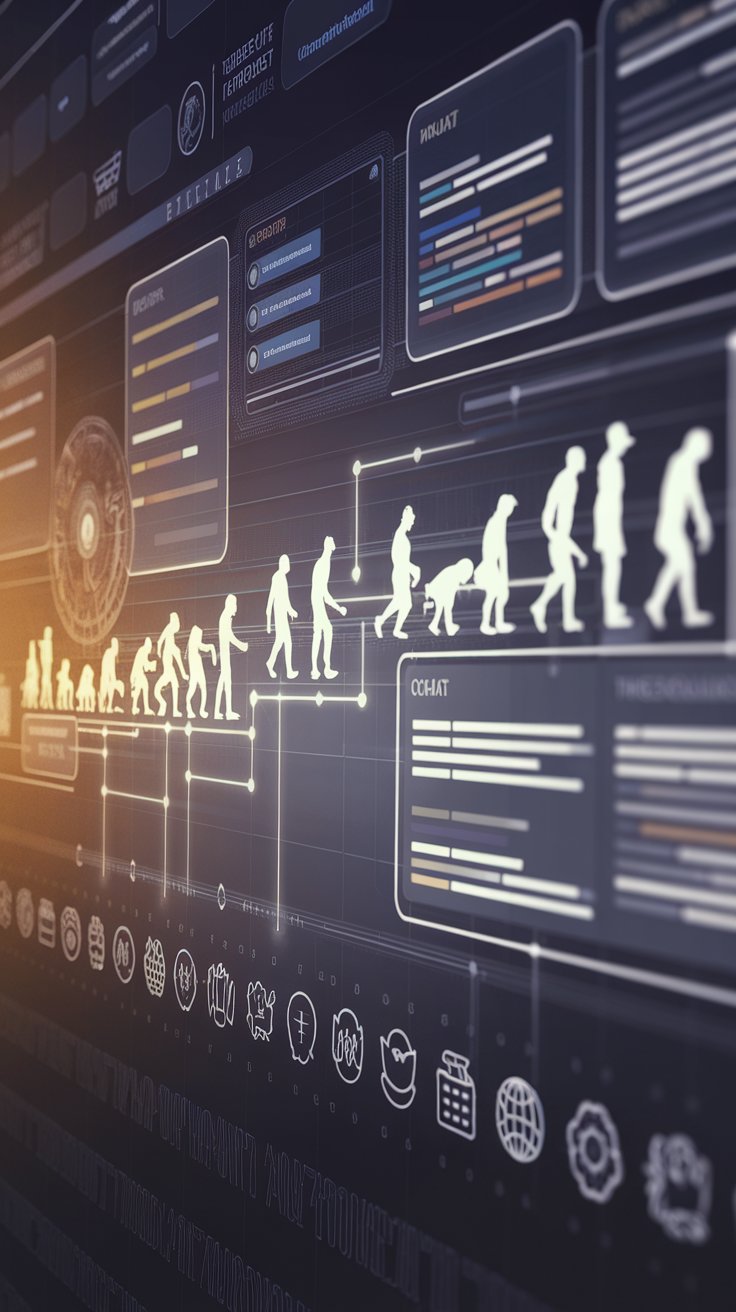Introduction
In today’s fast-paced digital environment, Chat Innovations are setting new benchmarks for user engagement through advanced chat widget functionalities on websites. These innovations, powered by generative artificial intelligence, allow for seamless, conversational experiences between users and businesses. As businesses strive to improve customer interaction, chat widgets have transformed the way users seek assistance, making them feel more connected to the brands they engage with. The ability of chatbots to process natural language and simulate human-like conversations presents a significant leap forward for both customer satisfaction and business efficiency.
From enhancing customer service to personalizing interactions and optimizing conversion rates, these developments are reshaping the online landscape. The integration of artificial intelligence within these widgets not only streamlines communication but also provides insightful analytics that help businesses tailor their services to meet user needs effectively. Join us as we examine the pivotal role of chat innovations in transforming the digital customer service experience.
The Evolution of Chat Technologies
From Early Chatbots to Generative AI
Chat technologies have undergone significant transformation since the inception of the earliest chatbots in the 1960s. Early models, such as ELIZA, utilized simple pattern matching techniques to simulate conversation, primarily serving as a therapeutic tool. These rudimentary scripts laid the groundwork for understanding user intent and created a template for what would evolve into more sophisticated interaction methods.
As the internet gained popularity in the late 1990s and early 2000s, chat technologies began to flourish, driven by the need for enhanced customer engagement. The introduction of rule-based bots revolutionized interactions, allowing businesses to offer basic customer support. These bots operated on pre-defined scripts, enabling them to respond to frequently asked questions but lacking the ability to learn from interactions.
With advancements in natural language processing and machine learning, chat technologies took a leap forward in the 2010s. This era saw the emergence of intelligent chatbots that, equipped with machine-learning algorithms, could adapt and improve based on user interactions. These innovations expanded the applicability of chat solutions in sectors like e-commerce, hospitality, and health care, where real-time support became crucial.
In recent years, the development of generative AI has redefined the conversational landscape. Chatbots powered by generative models, such as OpenAI’s GPT-3, can engage in more natural, dynamic conversation, understanding context and nuance in ways their predecessors could not. These advancements have transformed customer experiences by making interactions feel more human-like and tailored. Customers now expect seamless assistance that caters to their unique needs, reflecting a major shift in how businesses approach communication.
The proliferation of mobile devices has led to the rise of chat solutions that prioritize accessibility and immediate response. As customers increasingly seek instant answers, businesses have adapted by integrating chat technologies into their websites and mobile applications, ensuring that support is just a click away. This evolution has not only improved customer satisfaction but has also led to higher conversion rates and increased customer loyalty.
Through this historical lens, it is clear that the evolution of chat technologies has had a profound impact on customer experiences. By continually advancing from basic scripted responses to sophisticated, intelligent conversations, these innovations have reshaped the way businesses interact with their customers, fostering better relationships and enhancing overall service quality.
Features of Modern Chat Widgets Redefining Free Website Chat Widget Experience
Real-Time Functionalities
The digital landscape demands immediacy, making real-time functionalities a hallmark of modern chat widgets. Users expect swift interactions, and contemporary widgets meet these expectations by employing technologies like WebSocket. This allows for instant communication between users and agents. As soon as a user initiates a chat, the system notifies the relevant personnel, ensuring prompt responses. Real-time functionalities also extend to multi-channel support, enabling users to switch from SMS to a website chat seamlessly, improving the overall interaction flow.
Analytics
Analytics features have transformed chat widgets from mere communication tools into robust data-gathering platforms. Modern chat widgets not only record user interactions but also analyze them to derive valuable insights. Metrics such as response times, user satisfaction levels, and the effectiveness of different conversation paths can be tracked. By employing these analytics, businesses can assess their chat performance, understand customer preferences, and refine their strategies accordingly. This data-driven approach enhances decision-making and helps in tailoring the chat experience to better meet user needs.
Integrations with Other Platforms
Integrating chat widgets with other platforms has become essential in offering a cohesive user experience. Modern chat solutions often come equipped with the capability to integrate with various Customer Relationship Management (CRM) systems, ticketing solutions, and social media platforms. This interconnectedness allows for seamless transitions between different customer service channels, making it easier for businesses to maintain context during user interactions. For instance, if a user initiates a chat and subsequently needs to escalate the issue via a support ticket, both the chat history and user data can be transferred effortlessly, ensuring continuity in service and enhancing efficiency.
APIs play a crucial role in these integrations. They allow developers to customize chat solutions for specific business needs, enabling companies to deliver tailored experiences. With the integration of Artificial Intelligence capabilities, chat widgets can offer advanced functionalities such as natural language processing, which further personalizes the user experience by understanding user intent and tone.
The comprehensive features of modern chat widgets—from real-time interactions to rich analytics and extensive integrations—are paving the way for a redefined user experience. These innovations not only foster engaging conversations but also serve as strategic tools for businesses to enhance their customer service approaches.
Enhancing Customer Support with Chat Innovations
Redefining Free Website Chat Widget Experience
In the rapidly shifting landscape of customer service, chat innovations are becoming pivotal in redefining how businesses can effectively engage with their customers. Free website chat widgets, powered by intelligent chat solutions, are elevating service delivery across various industries by augmenting responsiveness and efficiency. A key aspect of this evolution lies in the integration of artificial intelligence (AI) and machine learning, which enable these chat widgets to intuitively cater to customer inquiries.
One remarkable feature of modern chat widgets is their ability to handle multiple queries simultaneously. This functionality not only minimizes wait times for customers but also frees up human agents to address more complex issues. For instance, a retail company using an AI-driven chat widget can simultaneously address inquiries about product availability, refunds, and order tracking, all while maintaining a high level of accuracy. The result is a streamlined customer experience that builds loyalty and satisfaction.
Another innovation enhancing chat widgets is natural language processing (NLP). By understanding and processing human language, these chat solutions can interact in a more human-like manner, making conversations feel personalized and less scripted. Customers are more likely to engage positively with a chat interface that understands their queries in context rather than responding with generic answers. This improvement in interaction quality encourages more users to utilize chat support rather than navigating through traditional customer service channels, such as phone calls or emails.
In various sectors, including e-commerce, finance, and healthcare, the impact of these innovations is evident. For example, financial institutions are employing chat widgets to provide instant responses to account inquiries, thereby giving customers immediate access to vital information. Similarly, healthcare providers are utilizing these tools to answer patient questions about appointments, reducing the administrative burden on staff and elevating the overall experience for patients.
The integration of analytics with chat innovations also allows businesses to assess performance metrics effectively. By measuring response times, customer satisfaction ratings, and conversation trends, companies can continually refine their chat support strategies, driving improvements in user experience. This cyclical process of feedback and enhancement leads to more refined support services, further solidifying the role of chat innovations in modern customer service frameworks.
The continuous development of intelligent chat solutions is not just enhancing customer support but also transforming the essence of online interactions, enabling businesses to provide responsive, personalized, and efficient service to their clientele.
Personalization in Chat Interactions Redefining User Engagement through Intelligent Solutions
The Impact of Personalized Experience on User Engagement
In the age of digital communication, the necessity for a personalized touch in chat interactions has never been more pertinent. Free website chat widgets equipped with advanced personalization features are rapidly transforming how users engage with brands. Traditional chat interfaces often provide generic responses, leaving customers feeling overlooked and unimportant. However, with intelligent chat solutions that harness user data, brands are now capable of delivering tailored interactions that resonate on a deeper level.
When chat widgets integrate personalization, they allow businesses to recognize returning users, adapt their conversational style, and suggest relevant products or services based on previous interactions. This attention to user preferences not only enhances engagement but also significantly boosts customer satisfaction. Enthusiasts of such innovations illustrate that personalized interactions can lead to a remarkable increase in customer loyalty, as users feel a stronger emotional connection to brands that cater to their individual needs.
The technologies powering these enhancements generally include artificial intelligence and machine learning algorithms, which analyze user data to generate real-time suggestions. Some innovative chat widgets incorporate natural language processing capabilities that help decipher user intent, allowing the bot to respond in a manner that aligns with the user’s expectations. This leads to a more human-like interaction, effectively reducing frustration and creating an inviting atmosphere for engagement.
Advanced personalization features can also track user behavior across multiple platforms, enabling chatbots to provide coherent experiences regardless of where the interaction occurs. For example, if a user browses a website and subsequently engages with the chat widget, the AI can pull up relevant information from their browsing history, thereby making informed suggestions and enhancing the likelihood of conversion. Some chat solutions even allow users to customize the chat experience by selecting their preferred language or chat themes, adding another layer of personalization to the interaction.
The implementation of personalization in chat experiences is not merely a trend but a pivotal shift in enhancing user engagement. With businesses striving to create meaningful connections in a crowded digital marketplace, leveraging these innovations will be key to fostering enduring relationships with customers. As chat solutions continue to evolve, brands that prioritize personalization stand to gain a significant competitive advantage, paving the way for exceptional experiences that resonate long after the conversation ends.
The Future of Chat Innovations Redefining Free Website Chat Widget Experience
The path ahead for chat innovations hints at a transformative era where user experience will consider a variety of dynamic features. As free website chat widgets evolve, integration of advanced technologies such as artificial intelligence, machine learning, and natural language processing will shape interactions in unprecedented ways. Businesses are increasingly recognizing the need for intelligent chat solutions to engage customers meaningfully, moving beyond traditional question-and-answer paradigms.
Anticipated Trends in Chat Innovations
In the coming years, chat interfaces are likely to become even more intuitive and context-aware. With the growing capabilities of machine learning algorithms, chat widgets could more accurately discern user intent and emotions, leading to interactions that feel natural and human-like. For example, using sentiment analysis, chatbots will be able to assess the emotional tone of a customer’s query, adjusting responses accordingly to enhance the engagement experience. This level of sophistication will not only provide immediate solutions but also build deeper connections between brands and consumers.
The incorporation of voice and visual interaction in chat solutions will also become more pronounced. As voice recognition technology advances, chatbots may evolve to facilitate seamless conversations through speech, allowing users to engage without necessitating text input. Similarly, the utilization of visual elements—such as emojis, GIFs, or video snippets—within chat interactions can make exchanges more expressive and relatable. This diversification of communication methods will cater to various user preferences, ensuring that every customer finds their ideal mode of interaction.
Implications for User Experience
These innovations will significantly enhance user experience by fostering personalization and contextually relevant interactions. By leveraging historical chat data and user preferences, chat widgets can create tailored experiences that resonate with individuals, further boosting customer satisfaction. Furthermore, the integration of predictive analytics may empower chatbots to provide proactive assistance, anticipating user needs even before questions arise. This proactive engagement not only saves time but also creates a seamless interaction flow.
As chat innovations continue to advance, they will increasingly be integrated across various platforms and channels. The omnipresence of chat solutions will enable users to transition effortlessly between different interfaces—say, from social media messaging to a company’s website—and expect a consistent, cohesive experience. Such integration will drive efficiency and enhance user trust in brand communications.
Challenges and Limitations of Current Chat Solutions
Challenges in Implementing Chat Innovations
Despite the advancements in chat innovations that promise to enhance user engagement and streamline communication, organizations frequently encounter significant challenges during implementation. One primary obstacle is the integration of chat solutions with existing systems. Many businesses utilize a variety of platforms for customer relationship management, sales, and support. Outdated technology can hinder the seamless operation of new chat functions, leading to fragmented user experiences and inefficiencies.
Another critical challenge is varied user expectations. Customers today demand immediate, relevant, and intelligent interactions. In response to these demands, chat solutions must not only be able to provide quick responses, but they also need to comprehend context, history, and intent. However, many current chatbots struggle with nuanced conversations, which results in user frustration and a sense of disconnect between the organization and the customer.
Limitations of Current Technologies
Current chat technologies often struggle with scalability, particularly for businesses experiencing rapid growth. A free chat widget may not perform optimally as user interactions increase, leading to slower response times and potential crashes. This limitation deters organizations from relying solely on these tools for essential customer interactions and necessitates the integration of more robust, paid solutions.
The effectiveness of chatbots is often limited by their programming. Many systems operate on predefined scripts, which restrict their ability to adapt to varying inquiries. In scenarios where human-like empathy and understanding are requisite for successful engagement, these scripted interactions can fall short, affecting customer satisfaction and trust. Furthermore, the lack of personalization capabilities keeps chat solutions from genuinely resonating with users, as tailored experiences are central to building relationships.
To address these limitations, organizations must invest in ongoing training and development for their chat systems. This includes incorporating machine learning algorithms that can adapt based on interactions and user behavior. Regular updating and refining of chat scripts, along with implementing omnichannel capabilities, could enhance overall communication efficacy.
While chat innovations have made substantial strides in enhancing free website chat widget experiences, understanding and overcoming these challenges is critical for organizations seeking to optimize their online interactions.
Conclusions
The evolution of chat innovations, particularly around website chat widgets, has markedly improved user interactions across various platforms. By harnessing advanced technologies, companies are now equipped to handle customer inquiries more efficiently and in a more personalized manner. This evolution not only enhances customer satisfaction but also drives performance metrics such as conversion rates and customer retention. The adaptability and intelligence of these chat solutions empower businesses to engage their audience more effectively, fostering stronger relationships between brands and users.
Moving forward, it is evident that embracing these innovations will be crucial for businesses aiming to stay competitive in the digital marketplace. As artificial intelligence continues to advance, we can expect chat widgets to become even more sophisticated, thereby further enhancing the user experience. The future promises more intuitive and responsive chat solutions that will redefine how businesses interact with their customers online, turning challenges into opportunities for growth.


















